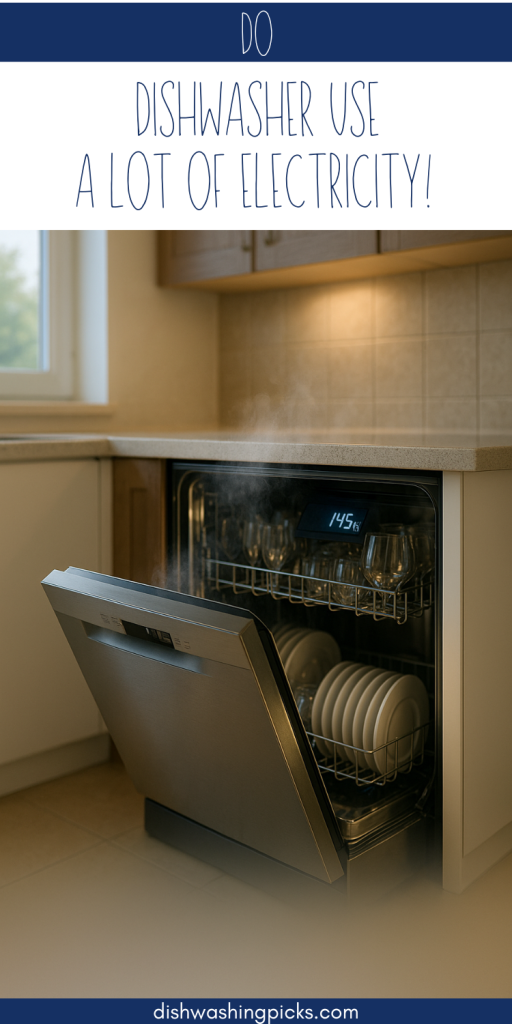
First Things First: Is That “Start” Button Draining Your Wallet?
You’re staring at your dishwasher, full to the brim with the aftermath of dinner.
And right before you hit Start, you pause.
“Wait… does this thing actually cost a lot to run?”
Totally fair question. You’re not alone—most people aren’t sure whether dishwashers are energy hogs or unsung eco-heroes. Spoiler: the answer’s not black and white, but it is more friendly to your wallet (and the planet) than you might think.
Let’s break it down and see if your dishwasher is a silent spender or a surprisingly savvy saver.
So… How Much Electricity Does a Dishwasher Really Use?
Alright, let’s talk numbers—but in a non-boring way, promise.
On average, a modern ENERGY STAR-rated dishwasher uses about 1.17 kWh per cycle. Depending on your local electricity rate, that’s roughly 15 to 25 cents per run.
Yep, a quarter or less.
Not too bad for a machine that:
- heats water
- sprays jets at high pressure
- sanitizes at high temps
- and sometimes dries your dishes too
Try thinking of it like this: Running your dishwasher is kinda like brewing a few cups of coffee. Not free—but also not breaking the bank.
And compared to older models? Modern dishwashers are absolute efficiency machines.
What Affects How Much Electricity a Dishwasher Uses?
Alright, so your dishwasher doesn’t technically devour energy, but that doesn’t mean all cycles are created equal. Some settings? Energy guzzlers. Others? Surprisingly gentle.
Let’s break it down:
1. The Drying Cycle Is a Secret Energy Vampire
You know that moment after your dishwasher finishes, and everything’s bone dry and toasty warm? That’s thanks to the heated drying element—and it uses a decent chunk of electricity.
Fun fact: That little drying cycle can use more than half the energy of the whole wash.
The fix? Use the air-dry setting (if your machine has one) or just crack the door open when the cycle ends. It’s like sun-drying your clothes… but for forks.
2. Hot Water Heating = Hidden Cost
Dishwashers don’t heat all their water internally (unless you’ve got a fancy one with its own heater). Most pull hot water straight from your water heater. So if you’ve got an older or inefficient water heater? You’re paying for it.
Try this: Run hot water in your sink for a few seconds before starting your dishwasher. That way, the dishwasher gets hot water right away and doesn’t waste electricity waiting for it to warm up.
Also, lower your water heater temp to 120°F (49°C). It’s still hot enough to clean and saves energy across the board.
3. Cycle Choice Makes a Big Difference
That “normal” cycle? Usually a good balance.
But the “sanitize,” “heavy,” or “pots and pans” settings? Those crank up the heat—and your electric bill.
Think of it this way: Choosing a high-heat, intense cycle for a load of cereal bowls is like using a flamethrower to light a birthday candle. Overkill.
Use the right cycle for the job. For everyday dishes, normal or eco modes are perfect.
How to Keep Your Dishwasher’s Energy Use Low
Okay, now that we know where the electricity goes, let’s talk about keeping those watts—and that bill—under control.
Here’s what smart dishwasher users do:
Run full loads only
Seems obvious, but it’s easy to forget. Half-loads use nearly the same energy as full ones.
Use eco or energy-saver modes
These are slower, yes—but they sip electricity, not chug it.
Skip pre-rinsing
Modern dishwashers are designed to handle a little mess. Pre-rinsing not only wastes water but can confuse sensors, leading to longer cycles. Let the machine do its job.
Clean the filter regularly
Clogged filters make your dishwasher work harder. A quick clean keeps things running efficiently—and keeps your dishes from coming out grimy.
Final Thoughts: Are Dishwashers Electricity Monsters?
Not even close.
In fact, for most households, dishwashers are actually more efficient than handwashing—both in water and electricity, especially if you’re using a modern, ENERGY STAR-rated model and skipping the extras (like heated drying).
⚡ Imagine this: You hit “start,” walk away, and in a couple of hours—your dishes are done. Clean. Sanitized. And it cost you less than a snack-sized bag of chips. Worth it? We think so.
